
Quinapril (trade name Accupril) is a drug used to treat hypertension and congestive heart
failure.
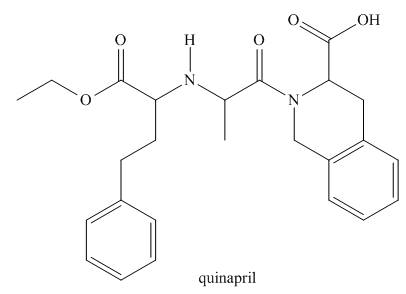
a. Identify the
b. Classify any alcohol, amide or
c. At which sites can quinapril hydrogen bond to water?
d. At which sites can quinapril hydrogen bond to acetone
e. Label the most acidic hydrogen atom.
f. Which site is most basic?
(a)
Interpretation: The functional groups present in the given compound, quinapril are to be identified.
Concept introduction: An atom or a group of atoms that shows characteristic physical and chemical properties are collectively known as functional groups. The functional group is the most reactive part present in the molecule. The main functional groups are
Answer to Problem 3.60P
The functional groups present in the given compound, quinapril are shown below.

Explanation of Solution
The functional groups present in the given compound, quinapril are shown as,

Figure 1
Thus, there are total four functional groups present in quinapril which are ester group, amine group, amide group and carboxylic group as highlighted above. There are two aromatic also present in the given compound, quinapril.
There are total four functional groups present in quinapril which are ester group, amine group, amide group and carboxylic group.
(b)
Interpretation: The alcohol, amine or amide groups present in the given compound, quinapril are to be classified as
Concept introduction: The amine, amide or alcoholic groups are identified as primary
Answer to Problem 3.60P
The classification of alcohol, amine or amide groups present in the given compound, quinapril as
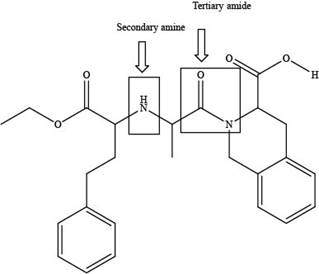
Explanation of Solution
The classification alcohol, amine or amide groups present in the given compound, quinapril are shown as,
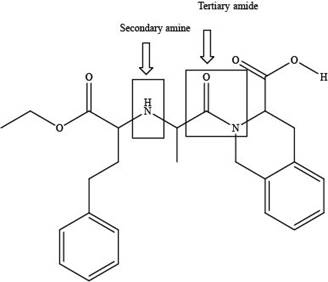
Figure 2
The given compound consists of one tertiary amide and one secondary amine as shown above.
The classification of alcohol, amine or amide groups present in the given compound, quinapril as
(c)
Interpretation: The site at which quinapril forms hydrogen bond with water is to be predicted.
Concept introduction: The bonding that takes place between hydrogen atom and hetero atoms like oxygen, nitrogen and fluorine is known as hydrogen bonding. In case of water, hydrogen atom makes bond with each other. Hydrogen bonding is the strongest bonding among the intermolecular forces and covalent bonding.
Answer to Problem 3.60P
The site at which quinapril forms hydrogen bond with water is shown below.
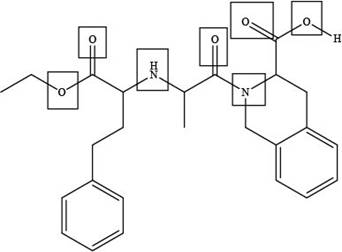
Explanation of Solution
The site at which quinapril forms hydrogen bond with water is shown as,

Figure 3
In the given compound, the sites where the electronegative atoms like, oxygen and nitrogen are present, there only hydrogen bond forms with water as highlighted above.
The site at which quinapril forms hydrogen bond with water is shown in Figure 3.
(d)
Interpretation: The site at which quinapril forms hydrogen bond with acetone is to be predicted.
Concept introduction: The bonding that takes place between hydrogen atom and hetero atoms like oxygen, nitrogen and fluorine is known as hydrogen bonding. In case of acetone, hydrogen atom makes bond with that electronegative atom which is attached to hydrogen atom only. Hydrogen bonding is the strongest bonding among the intermolecular forces and covalent bonding.
Answer to Problem 3.60P
The site at which quinapril forms hydrogen bond with acetone is shown below.
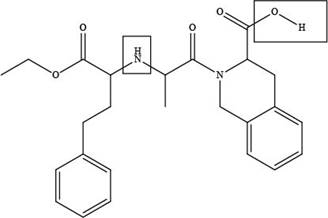
Explanation of Solution
The site at which quinapril forms hydrogen bond with acetone is shown as,

Figure 4
In the given compound, the sites where the electronegative atoms like, oxygen and nitrogen attached to other hydrogen atom are present, there only hydrogen bond forms with acetone as highlighted above.
The site at which quinapril forms hydrogen bond with acetone is shown in Figure 4.
(e)
Interpretation: The most acidic hydrogen present in the given compound, quinapril is to be labeled.
Concept introduction: The most acidic hydrogen
Answer to Problem 3.60P
The labeling of the most acidic hydrogen present in the given compound, quinapril is shown below.
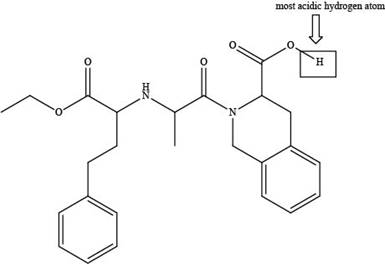
Explanation of Solution
The labeling of the most acidic hydrogen present in the given compound, quinapril is shown as,

Figure 5
The electronegativity increases while moving left to right in the period. Thus, oxygen is more electronegative than nitrogen atom as it is located at the extreme right position. According to the structure of quinapril, hydrogen atom that is bonded with oxygen atom is the most acidic one because oxygen is more electronegative than nitrogen atom. The higher electronegativity corresponds to the greater acidic character of hydrogen atom attached to the electronegative atom.
The labeling of the most acidic hydrogen present in the given compound, quinapril is shown in Figure 5.
(f)
Interpretation: The most basic site in the compound quinapril is to be labeled.
Concept introduction: According to Bronsted-Lowry theory, the species that easily tends to accept the proton is known as base and the species that easily donate the proton is known as acid. The high delocalization of electron pair corresponds to the high basic character of the atom.
Answer to Problem 3.60P
The labeling of the most basic site in the compound quinapril is shown below.
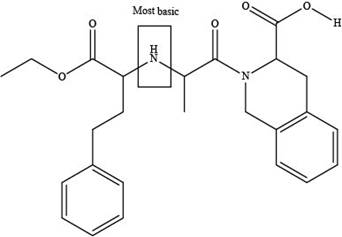
Explanation of Solution
The labeling of the most basic site in the compound quinapril is shown as,

Figure 6
According to the structure of quinapril, the site at which amide group is present is the most basic site because in amides, the pair of electrons over nitrogen atom gets highly delocalized. Hence, the most basic site is present at tertiary amide.
The labeling of the most basic site in the compound quinapril is shown in Figure 6.
Want to see more full solutions like this?
Chapter 3 Solutions
Organic Chemistry
- 1. What functional group increases the boiling point of straight chain primary alcohols and carboxylic acids by 18 degrees Celsius? methane methylane ethylene methylene 2. What type of bonds are present between alcohol molecules that allow them to have a higher boiling point than saturated hydrocarbons? A. Van der Waals forces B. hydrogen bond C. london forces D. dipole-dipole bonds 3. It is a compound composed of 2 similar subunits or held together by ionic or covalent bonds. primer chiral monomer dimerarrow_forwardExplain why a 1 ° amine and a 3 ° amine having the same number of carbons are soluble in water to a similar extent, but the 1 ° amine has a higher boiling point.arrow_forward1)Draw the structure of salicylic acid. Circle the phenol functional group. 2) Aspirin can irritate the stomach. Circle and name the functional group responsible for the irritation of the stomach.arrow_forward
- Jj.166. Draw each amide. N-butyl-N-methylbenzamidearrow_forwardClassify each statement as a property of ethers, alcohols, or both ethers and alcohols. 1. These compounds cannot form hydrogen bonds between themselves, but they can form hydrogen bonds with other compounds containing an O−HO−H , N−HN−H , or F−HF−H bond, such as water.2. These compounds are water soluble if they have fewer than four carbon atoms.3. When comparing ethers and alcohols of similar molecular weights, these compounds have the higher boiling point. alcohols both ethers and alcohols ethersarrow_forwarda. What is the chemical structure of biphenyl? b. Is it polar or nonpolar? _______________________ c. What is its water solubility in g/L? __________________________arrow_forward
- 1. which one is water-soluble based on their structure? pls explain whya. vitamin A b. vitamin B3 c. vitamin E d. both b and C2. arrange from most soluble to least soluble in watera. methanol b.1-butanol c. ethylene glycol d. 2-octanolarrow_forward1. Which statement is correct? A. Aldehydes and ketones can hydrogen bond with other aldehydes and ketones. B. Aldehydes and ketones can hydrogen bond with water. C. Aldehydes and ketones cannot hydrogen bond with water. D. Aldehydes and ketones are always soluble in water.arrow_forwardDraw a structure for a lactone with 5 carbonsarrow_forward
- What kind of solvent ingredients is usually used in the concentrations of 4-10 percent in skin care products and their function is to soften skin cells and to lessen wrinkles? A. Ethly acetate B. Alpha hydroxyl acids C. Phenols and phenol derivatives D. Aliphatic alcoholsarrow_forward1. What functional group is produced when an aldehyde reacts with H2/Pt? A.secondary alcohol B. carboxylic acid C.hemiacetal D. primary alcohol E.alkane F.tertiary alcohol G. alkene 2. What reaction occurs when an aldehyde reacts with H2/Pt to form a primary alcohol? A. Hydration B. Hydration C. Dehydration D. Oxidation E. Reduction( hydrogentation) 3. What reaction occurs when an Ester react with H+/H2O to from a carboxylic acid and alcohol? A. Dehydration B. Reduction ( Hydrogenation) C.Hydrolysis D. Hydration E.oxidationarrow_forwardWhat amine is formed by reduction of each amide?arrow_forward
 Chemistry: An Atoms First ApproachChemistryISBN:9781305079243Author:Steven S. Zumdahl, Susan A. ZumdahlPublisher:Cengage Learning
Chemistry: An Atoms First ApproachChemistryISBN:9781305079243Author:Steven S. Zumdahl, Susan A. ZumdahlPublisher:Cengage Learning
 ChemistryChemistryISBN:9781305957404Author:Steven S. Zumdahl, Susan A. Zumdahl, Donald J. DeCostePublisher:Cengage Learning
ChemistryChemistryISBN:9781305957404Author:Steven S. Zumdahl, Susan A. Zumdahl, Donald J. DeCostePublisher:Cengage Learning- Chemistry: Matter and ChangeChemistryISBN:9780078746376Author:Dinah Zike, Laurel Dingrando, Nicholas Hainen, Cheryl WistromPublisher:Glencoe/McGraw-Hill School Pub Co





